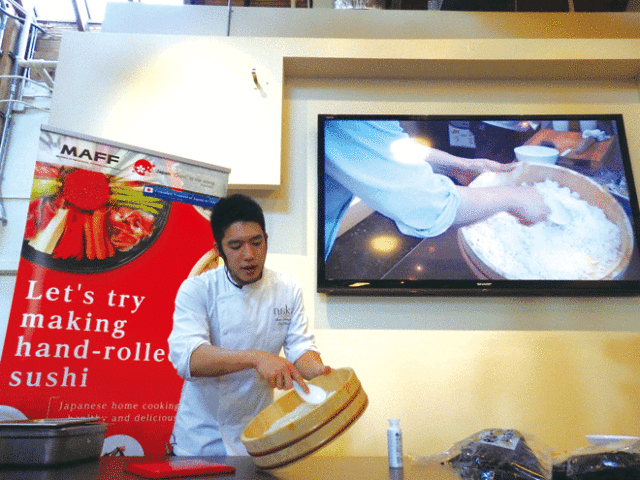
By Fumika Iwasaki The North American Post
A sushi making workshop called “Let’s try making Hand-rolled Sushi” was held on Jan. 24 at Pike Place Market hosted by the Ministry of Agriculture, Forestry, and Fisheries (MAFF) to promote Japanese food and culture.
MAFF is aiming to expand the volume of exports of agriculture, forestry and fishery products and food products up to a value of nearly ten billion dollars by 2020.

After the Great East Japan Earthquake in 2011, the volume of exports was down but in 2015 Japan recorded a record seven billion dollars in exports. The agency has made an effort to increase exports through introducing Japanese recipes and foods for the home.
“Japanese food has long history, and Washoku (Japanese food) has been recognized by UNESCO as an intangible cultural heritage since 2013,” said Naoki Hayasaka, a Japanese consul. “Japanese food is not just of a physical and concrete form, so we would like to hand it down carefully.
“And if you think it is delicious, please say Oishii (delicious in Japanese).”
The same events were already held in Spain, Denmark, Malaysia and Canada.
Shota Nakajima, executive chef of local Japanese restaurant NAKA, joined the event as a lecturer, explaining Washoku, demonstrating Kaiseki—an authentic elegant Japanese meal—and teaching attendees how to make handrolled sushi.
 The workshop participants enjoyed eating their own sushi after s t r u g g l i n g somewhat to make it. While i n s t r u c t o r s walked around the tables to help, Nakajima was asked about tricks to make beautiful sushi rolls.
The workshop participants enjoyed eating their own sushi after s t r u g g l i n g somewhat to make it. While i n s t r u c t o r s walked around the tables to help, Nakajima was asked about tricks to make beautiful sushi rolls.
Since Seattle locals have many opportunities and options to eat Japanese food at restaurants, Consul Hayasaka said that the next challenge is integrating Japanese foods into home cooking.
He added that it will not be easy to promote real Japanese food in homes, and that teaching not only chefs but ordinary family members how to cook Japanese cuisine is a key for the future.



